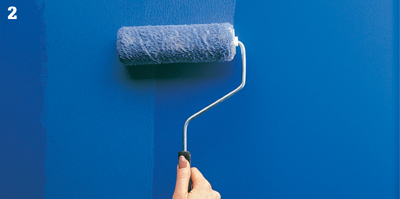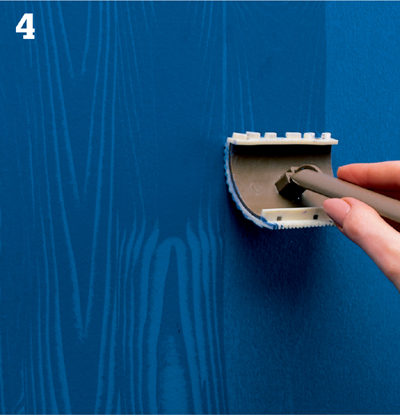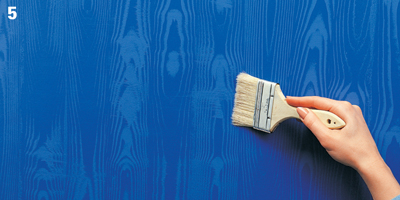 23. Faux Moiré Finish
23. Faux Moiré Finish 23. Faux Moiré Finish
23. Faux Moiré FinishThe watermarked look of silk moiré fabric can be created using a rocker tool designed for wood graining. A paint glaze is applied over a base coat of paint, and the graining tool is pulled and rocked through the glaze to create impressions. Then, a dry paintbrush is pulled across the markings to mimic the crosswise grain of moiré. This dramatic tone-on-tone finish is recommended for small areas, such as the space below a chair rail or within frame moldings.
The bright sheen that is characteristic of moiré fabric is simulated by using a darker shade of low-luster latex enamel for the base coat and a lighter shade for the top coat glaze. You can use the same paint for both coats by lightening the top coat with white paint.
The glaze used for faux moiré contains more paint than most glazes, making it thicker and more opaque. Apply the glaze to a small area at a time so that you will have enough time to finish the graining before the glaze dries. If you are finishing the wall area below a chair rail or border, work from the chair rail down to the baseboard in 12"-wide sections.


 How to Apply a Faux Moiré Finish
How to Apply a Faux Moiré Finish
Apply the base coat of low-luster latex enamel, using a paint roller or paintbrush. Allow the paint to dry.

Mix the glaze for the top coat. Apply an even coat of glaze over the base, rolling or brushing vertically. Work in small areas to ensure the paint remains wet as you work it.
Slide the graining tool vertically through the wet glaze, occasionally rocking it slowly back and forth, to create the watermarked effect. Start at one corner, working in one continuous motion as you slide and rock the tool from one end to another. The simultaneous rocking and sliding motions create elongated oval markings.

Repeat Step 3 for subsequent rows. Stagger the oval markings so that they appear randomly placed, and work quickly before glaze dries. Wipe the excess glaze from the tool as necessary, using a dry rag.

When the glaze has partially dried, pull a dry natural-bristle paintbrush horizontally across the surface; this mimics the crosswise grain of the moiré fabric. Wipe excess glaze from the brush as necessary. Allow the paint to dry.